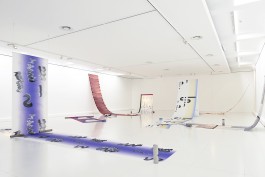
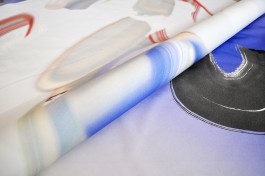
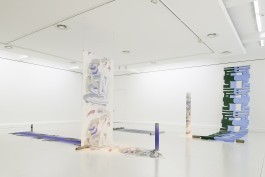

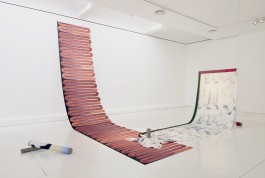
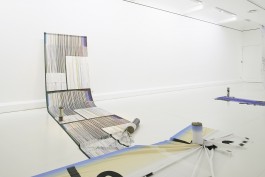
solid solutions / soft skills is the first collaboration by the artists Stefanie Kägi and Selina Reiterer. The exhibition brings together their individual commitments to exploring the expanded possibilities of textiles. The installation, which shares the title of the exhibition, forms a homage to a statement made by Bauhaus member Anni Albers, who expressed that textiles have the ability to act as “counterparts to the rigid walls” of the museum. At the Kunstraum Engländerbau, Kägi and Reiterer have taken up this proposition, counterposing industrial-scale fabric banners with hand-cast concrete sculptures.
In their empowered and deliberate choice to reference female textile pioneers of the twentieth century, Kägi and Reiterer's political act is to work in ways that would not have been available to the artists that went before them. The Bauhaus, for instance, despite its progressive admission policy, only allowed women to train in the weaving workshop, which soon became known as the “women's workshop”. Kägi and Reiterer's two part title, solid solutions / soft skills, is as much a way to acknowledge the materials of the installation — the softness of the fabric contrasting the solidity of the concrete forms — as it is a strategy for addressing the changing world of work and the role that artistic practice plays within this shift.
“Soft skills” describes a cluster of social competences that are essential for navigating the world of work — empathy, emotional intelligence and language skills all fall under this umbrella term. Notoriously difficult to teach, these seemingly innate skills are personal qualities that are often, and certainly stereotypically, associated with women. The demand of such qualities is on the rise and in the advent of artificial intelligence, machine learning and robotic automation, “soft skills” are what will distinguish human labour from the machine workforce. The collaboration necessary for this installation, the coming together of two artists and their ability to negotiate, debate and create is indicative of their “soft skills”. Yet, the process is equally as informed by the “hard skills” of the artists’ specialisms: Kägi’s knowledge of painting and embroidery meets Reiterer's research into smart materials and traditional textile techniques.
...
“Solid solutions” chimes as if a slogan for corporate efficiency, but in fact the term is borrowed from chemistry. It describes two crystalline solids that, when in a solvent, form a new crystalline solid. This phrase creates a sensibility for the fact that in this installation the constituent parts remain separate and yet form a hybrid whole. The patterns on the fabric stem from Reiterer's rounded, felt-tip marker drawings and Kägi's gestural, painted marks, both of which were enlarged and digitally printed onto cloth. The cast concrete sculptures allude to the cardboard inner tubes onto which great lengths of fabric are rolled. Unlike their cardboard counterparts, the surfaces are irregular and pitted, as if architectural columns that have been weathered by exposure to the elements. They play a structural role in the installation with the fabric anchored and rolled onto these concrete forms. As objects they have the slightly absurd quality of being brand-new ancient-artefacts.
For Selina Reiterer and Stefanie Kägi, the analogue and the digital exist on a par with one another, not in dichotomy, nor in hierarchy. Given that the punch-card system of the Jacquard weaving loom was one of the forerunners of the computer, their stance is historically informed: Textiles and technology have always coexisted. The installation searches for hybrid forms in which digital and analogue processes nestle together, allowing the “solid solutions” of sculpture and the gendered connotations of “soft skills” to be reflected upon. What emerges is a new body of work that bristles with historical reflection and present-day urgency.
— Clare Molloy, Gropius Bau Berlin, 2019
Photography: Barbara Bühler